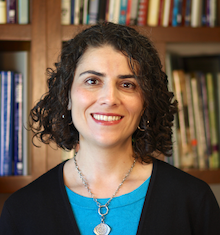
When instruction is learner-centered, teachers take on a facilitative, guiding role. According to Maryellen Weimer, author of Learner-Centered Teaching, faculty “position themselves alongside the learner and keep the attention, focus, and spotlight aimed at and on the learning process.” Teachers create climates for learning that move students steadily toward a place of intellectual maturity and responsibility, and they support students in learning from and with each other.
- How do you make students partners in the learning process?
- How do you encourage students to take ownership of their experience in your course?
- Where do students get to make choices in your course

Christina Ragan, Biological Sciences
In my research capstone course, I give the students the choice of what project they want to work on. I give them some examples so they aren’t completely starting from scratch. I give them a lot of feedback along the way to show that I am invested in their project. I guide them toward problem solving without telling them exactly what to do. I encourage the students to pick topics that they are naturally curious in. I want them to be proud of all their hard work and to feel like this is something that they wanted to do, not that they were forced to do. Students get to choose their projects and journal club papers to present on.

Linda Wills, Electrical and Computer Engineering
When I survey my students at the beginning of the semester, their most common concern is that they may not be sufficiently prepared. Their experiences in and mastery of prerequisite courses vary, making them unsure whether there are holes in their background knowledge that will trip them up. These doubts have increased with the uneven effects of the pandemic. In my course, I provide self-guided bridging material which includes targeted links to notes, practice problems, and lecture recordings of prerequisite material. This allows students to identify gaps and gain a sure footing.
In our final (embedded systems) project, the students complete a set of required baseline features for a C level grade, and can then choose from a menu of advanced feature ideas to earn increasingly higher grades, including extra credit (capped at a certain threshold for their sanity). The students can also propose their own advanced feature ideas for instructor approval. This scheme allows students to tailor their project toward aspects of the course with which they most resonate and toward their personal interests. It also allows them to decide how to prioritize their efforts and manage their end of semester workload.

Srinivas Garimella, Mechanical Engineering
I remind them of what the expectations of a GT graduate, as one among approximately 200 of the best Mechanical Engineering graduates across the country, are, and that they must live up to those expectations. I remind them that the ME department is consistently ranked ~2nd in the nation, and a grade in the course has to mean the mastery of the topics. I tell them that by graduating from such an esteemed program in the country, they will not have any trouble finding a job. But the more important question is, whether they will be able to keep the job when a company hits troubled times; in other words, will they be the indispensable few that will be retained no matter what? I challenge them about not just keeping the job, but thriving under challenges that they are sure to meet in their careers. And that the preparation must start now, under the guidance and harmless environment of the classroom, rather than when their livelihood is at stake.
The students are allowed and encouraged to choose partners for Homework and Projects, and even the project topics. In this manner, they learn to work with each other in teams. In addition, by each student group doing a different design project, they learn not only their own projects, but also projects in that subject matter than others have done. The interactive nature of the class discussions ensures that.

Kate Pride Brown, History and Sociology
I utilize discussion frequently and make space in class for students to ask and answer their own and each other’s questions. I ask students to post questions related to the readings on Canvas, which helps them to think critically about the texts and helps me direct discussion toward issues that they found most intriguing when we meet for class.
Students are most engaged when the subject matter is of interest to them. So I allow them to choose their own term paper topic, as long as it is related to course subject matter. For their culminating assignment, they get to immerse themselves in the study of something that they find personally interesting — because they chose the topic themselves.
I allow students to select the topics for their term papers, which is usually the largest portion of their final grade. So their most important assignment is largely self-selected and self-directed, with my support and guidance. For smaller assignments, I usually allow students to choose the due dates themselves to best accommodate their personal schedules.

Eunhwa Yang, Building Construction
In my seminar-based course (BC6300), students have chances to lead a 45-60 minute discussion based on the assigned reading material. I explain various formats of leading discussions and lead the first few discussion sessions using different discussion formats. I find that students become very accountable and bring diverse structures of leading a session and thought-provoking questions to the class. This brings a partnership between me as an instructor and students as leaders in the classroom.
Students who lead discussions are responsible for designing and planning their 45-60 minutes of a discussion session, which brings ownership to the course. Also, as discussion participants, the rest of the students share their opinions and reflection based on the assigned readings. As students play both roles, discussion leaders and participants, I witness that students have become more comfortable speaking in a class and shown high engagement throughout almost 3-hour evening classes.
Students choose which topic/reading materials for their discussion leading sessions among the list of given topics. Also, I provide optional reading materials for graduate students and any students who want to pursue more readings around the course topics (BC6300 is currently cross-registered with undergrad (2000 level).

John Etnyre, Mathematics
In most of my upper level courses, I have a term paper that is a significant portion of the grade. I have the students meet with me in the first few weeks of the course to discuss possible projects and settle on one. This allows students to explore something they are interested in that is related to the course. Towards the end of the course, the students turn in a draft of the paper that is critiqued by one or two other students and then I ask students to reflect on their paper having read others. This allows students to see the process of writing and evaluating a paper as well as get peer feedback.

Carol Subiño Sullivan, Center for Teaching and Learning
My course has a community engagement component where students mentor high school students on the process of selecting and applying to college. Since my students are much closer to the experience than I am many of them have great ideas about helpful tools. I invite them to do short presentations to share strategies with each other. For example, I’ve had students share strategies and tools for student athletes interested in applying for athletic scholarships or prospective students interested in ROTC. In addition to presenting in class, I set up a space in Canvas to post these ideas for later reference. The other students can go back to this information and pick strategies, ideas, and tools that are relevant to the high school students they are mentoring.

Sal Barone, Mathematics
How do you make students partners in the learning process? I actually think it is somewhat the other way around, I am (at most) a partner in **their** learning process. Of course, they are the ones that do (most of) the learning, after all! I view my goal in the process as a facilitator, one who helps create a learning environment which makes deep understanding of the course topics a possibility, and the person who decides how to structure the course so that the learning process challenges the best students while not leaving anyone who strives to learn behind.
How do you encourage students to take ownership of their experience in your course? Probably one of the most obvious ways is by asking questions. If a student asks a question, I will answer by providing some details, but I will usually end the discussion with a question that I pose to the student. The question is meant to check if they understood what I said so far, give them some practice on thinking about the “what is the next step”, and also to keep them engaged in the learning process. But, in a very real and intentional way, my goal is to ensure that the students understand that they are the owners of their learning experience. I am just here to help, to make it a bit easier and make their efforts more effective.
Where do students get to make choices in your course? There are a multitude of resources in the course, and very few students have the bandwidth (or even desire) to explore all the possible resources. We have supplementary lecture videos which are 10 minutes long and cover all the main topics of the course, many recommended textbook problems for the topics, as well as annotated lecture notes, studios where students work in groups on worksheet problems, and PLUS sessions. The practice resources for the exams and quizzes are also typically more than any student would need to get sufficient practice in preparation for the assessments. These resources are **supplementary** in the sense that students have no grade associated to completing or attempting to use any of these resources. Students have a veritable smorgasbord of options available to learn Math 1554 in addition to the graded material. Every semester in the CIOS survey when I ask students which option was their favorite or most effective, a portion of the class will choose each of the options. Students choose the options that are the best for their particular learning style, their needs at the time, or to supplement the graded material to fill in gaps in their knowledge as needed.

Vivek Sarkar, Computer Science
I provide worksheets for the students to work on collaboratively during the last 10 minutes of class. Each worksheet problem is based on the material taught earlier in the same lecture. Worksheets are turned in, but are not graded, though students get class participation credit for turning in worksheets. In my opinion, students find it liberating to work together in a collaborative way without worrying about honor code issues. The energy level and conversation buzz in the classroom definitely increase during the worksheet period. I also discuss the solutions to the worksheet at the start of the next class, which serves as a nice way to recap what was taught in the previous class.
I always give the students a lot of flexibility and the ability to make choices about what kind of system they build for their class project.
